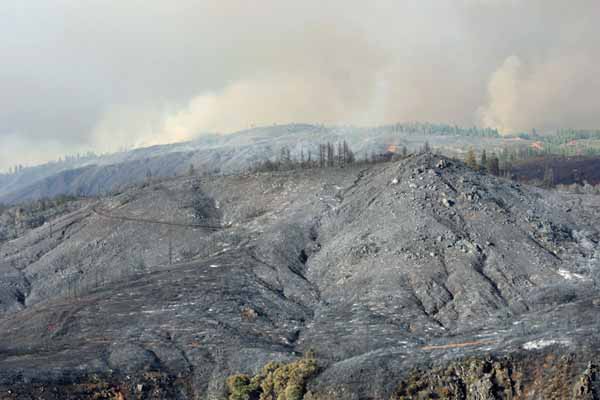
Recent research in the Rocky Mountains has found what others also determined in a 2013 study in Oregon — significant decreases in post-fire tree regeneration. In a paper titled “Evidence for declining forest resilience to wildfires under climate change”, eight researchers noted reductions in tree regeneration in the 21st century.
Below are some excerpts:
Annual moisture deficits were significantly greater from 2000 to 2015 as compared to 1985–1999, suggesting increasingly unfavourable post-fire growing conditions, corresponding to significantly lower seedling densities and increased regeneration failure. Dry forests that already occur at the edge of their climatic tolerance are most prone to conversion to non-forests after wildfires. Major climate-induced reduction in forest density and extent has important consequences for a myriad of ecosystem services now and in the future.
Climate change is already affecting multiple ecosystem properties, leading to shifts in species composition and state changes (Walther et al. 2002; Donato et al. 2016). In the US Rocky Mountains, we documented a significant trend of reduced post-fire tree regeneration, even over the relatively short period of 23 years covered in this analysis. Our findings are consistent with the expectation of reduced resilience of forest ecosystems to the combined impacts of climate warming and wildfire activity. Our results suggest that predicted shifts from forest to non-forested vegetation (e.g. Bell et al. 2014) may be underway, expedited by fire disturbances (Kemp 2015; Donato et al. 2016; Harvey et al. 2016; Johnstone et al. 2016; Rother & Veblen 2016).
Regeneration failures, as measured by both seedling presence/absence and regeneration thresholds, occurred across all forest types (Figs 3 and 4d). Low-elevation forests, dominated by tree species near the warm, dry edge of their climatic tolerance may be particularly vulnerable to shifts to non-forest vegetation, because of the absence of any tree species that could reestablish under warmer, drier conditions (Harvey et al. 2016). Meanwhile, moist forest types may experience a shift in species dominance and a decrease in tree density. And while only 15% of the moist forest sites we studied lacked seedling after 21st-century fires, 35% of these sites did not meet the recruitment threshold. This represents a substantial increase (300%) relative to the 1985–1999 period, highlighting the impacts of warming in moist forests as well.

There are areas that are burned to the point that soil beds are destroyed and recovery takes a very long time. When moisture levels are reduced it takes even longer. Sometimes non-native species that thrive in poor soil/growing conditions will take hold and change the composition of the vegetation. And sometimes areas just don’t support much of anything after a severe burn.
Jet Propulsion Laboratory Says California’s Drought Is Killing Oaks
Rosi Dagit, a senior conservation biologist with the Resource Conservation District of the Santa Monica Mountains, said in media reports about 9,000 oaks in the area have died because of the drought.
Dagit, along with her co-workers teamed with NASA’s Jet Propulsion Laboratory to study trees in the Santa Monicas.
The report was released in December and contained some harsh discoveries. For instance, between 2013 and 2016, about 30 percent of the 110,000 acres of live woods in the local mountains have died.
Dagit said oaks are the main species in the area and wildlife in the Santa Monica Mountains is dependent on the trees.
“There are literally thousands of species of insects, birds, reptiles, mammals and even fish, where if we lose oak trees all these other species disappear,” she said. “These species are tied, at least for certain parts of their life cycle, to the oaks.”
http://www.pasadenanow.com/main/jet-propulsion-laboratory-says-californias-drought-is-killing-oaks/#.WsZ65fnwY3U
Why is there no mention of the fact that the fires are burning hotter and more intensely and that is the cause of the DEAD SOIL. this article is completely as cued and misleading. If you are going to paint a picture. PAINT THE ENTIRE PICTURE!!
Did you click on the link and read the research?
AUSTIN: “Why is there no mention of the fact that the fires are burning hotter and more intensely and that is the cause of the DEAD SOIL. this article is completely as cued and misleading. If you are going to paint a picture. PAINT THE ENTIRE PICTURE!!”
===
Here, let me help finish that picture for you. The article Bill provided is on one of several, but to be even more thorough here is another headline from August 28th 2018. Seems to pretty well cover the bases on all fires.
“Low-severity wildfires impact soils more than previously believed”
https://www.dri.edu/newsroom/news-releases/5690-low-severity-wildfires-impact-soils-more-than-previously-believed
–